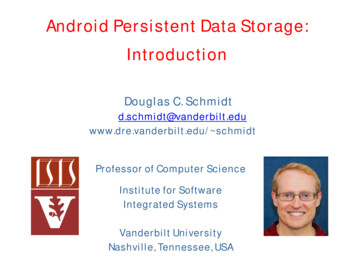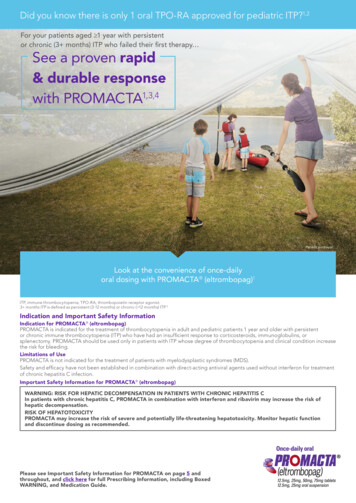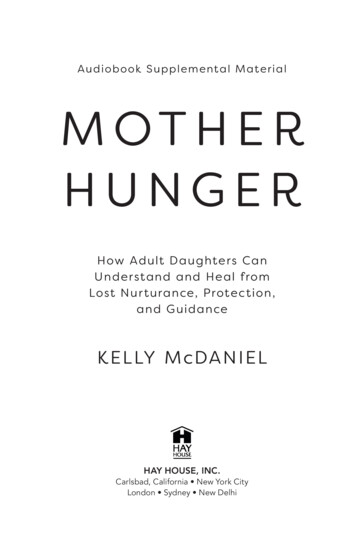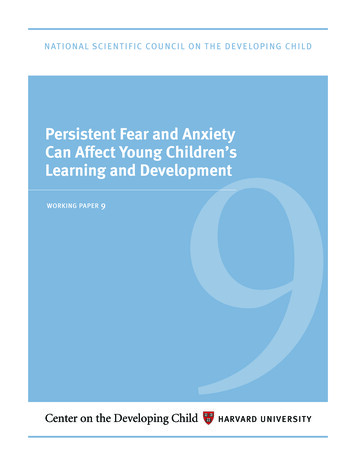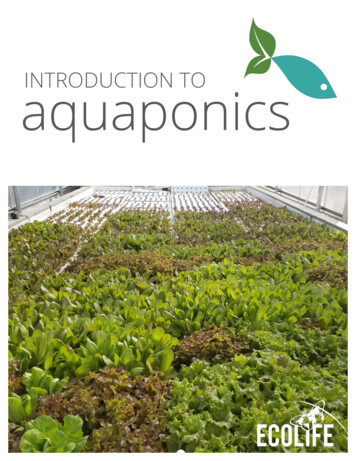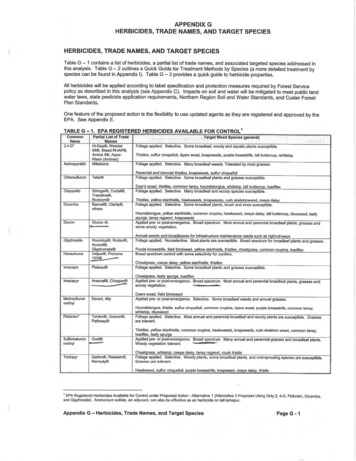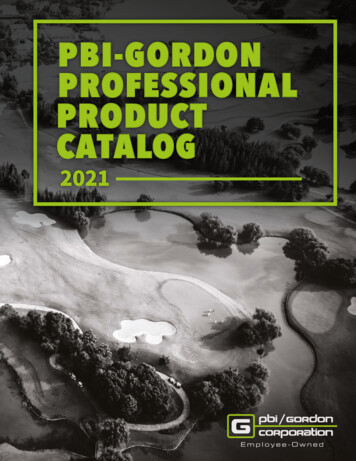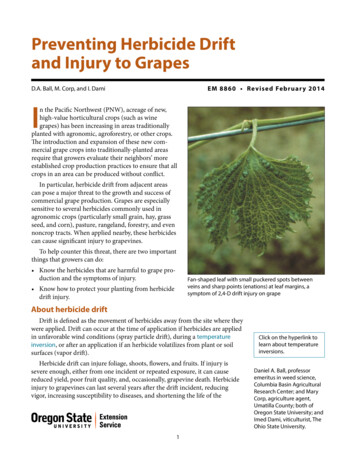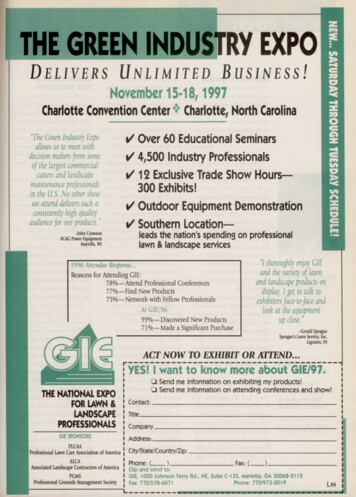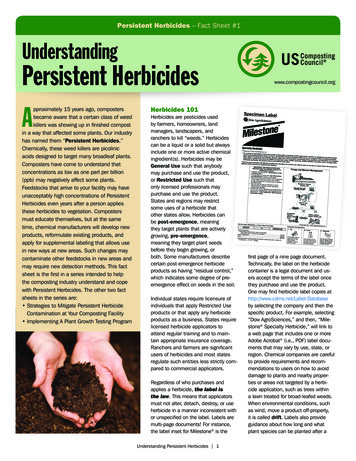
Transcription
Persistent Herbicides – Fact Sheet #1UnderstandingPersistent HerbicidesApproximately 15 years ago, compostersbecame aware that a certain class of weedkillers was showing up in finished compostin a way that affected some plants. Our industryhas named them “Persistent Herbicides.”Chemically, these weed killers are picolinicacids designed to target many broadleaf plants.Composters have come to understand thatconcentrations as low as one part per billion(ppb) may negatively affect some plants.Feedstocks that arrive to your facility may haveunacceptably high concentrations of PersistentHerbicides even years after a person appliesthese herbicides to vegetation. Compostersmust educate themselves, but at the sametime, chemical manufacturers will develop newproducts, reformulate existing products, andapply for supplemental labeling that allows usein new ways at new areas. Such changes maycontaminate other feedstocks in new areas andmay require new detection methods. This factsheet is the first in a series intended to helpthe composting industry understand and copewith Persistent Herbicides. The other two factsheets in the series are: Strategies to Mitigate Persistent HerbicideContamination at Your Composting Facility Implementing A Plant Growth Testing Programwww.compostingcouncil.orgHerbicides 101Herbicides are pesticides usedby farmers, homeowners, landmanagers, landscapers, andranchers to kill “weeds.” Herbicidescan be a liquid or a solid but alwaysinclude one or more active chemicalingredient(s). Herbicides may beGeneral Use such that anybodymay purchase and use the product,or Restricted Use such thatonly licensed professionals maypurchase and use the product.States and regions may restrictsome uses of a herbicide thatother states allow. Herbicides canbe post-emergence, meaningthey target plants that are activelygrowing, pre-emergence,meaning they target plant seedsbefore they begin growing, orboth. Some manufacturers describecertain post-emergence herbicideproducts as having “residual control,”which indicates some degree of preemergence effect on seeds in the soil.Individual states require licensure ofindividuals that apply Restricted Useproducts or that apply any herbicideproducts as a business. States requirelicensed herbicide applicators toattend regular training and to maintain appropriate insurance coverage.Ranchers and farmers are significantusers of herbicides and most statesregulate such entities less strictly compared to commercial applicators.Regardless of who purchases andapplies a herbicide, the label isthe law. This means that applicatorsmust not alter, detach, destroy, or useherbicide in a manner inconsistent withor unspecified on the label. Labels aremulti-page documents! For instance,the label inset for Milestone is theUnderstanding Persistent Herbicides 1first page of a nine page document.Technically, the label on the herbicidecontainer is a legal document and users accept the terms of the label oncethey purchase and use the product.One may find herbicide label copies athttp://www.cdms.net/Label-Databaseby selecting the company and then thespecific product. For example, selecting“Dow AgroSciences,” and then, “Milestone Specialty Herbicide,” will link toa web page that includes one or moreAdobe Acrobat (i.e., PDF) label documents that may vary by use, state, orregion. Chemical companies are carefulto provide requirements and recommendations to users on how to avoiddamage to plants and nearby properties or areas not targeted by a herbicide application, such as trees withina lawn treated for broad-leafed weeds.When environmental conditions, suchas wind, move a product off-property,it is called drift. Labels also provideguidance about how long and whatplant species can be planted after a
Persistent Herbicides – Fact Sheet #1herbicide application. Misuse of herbicide is aviolation of federal and state law. Federal andstate agencies have revoked licenses, fined,and even jailed, herbicide applicators aspunishment for violating the label. Somelabels explicitly require notification todownstream users such as facilitiesthat compost treated vegetation. Theproblem with notification requirementsare that most feedstocks for composting pass through many entities beforethey reach a composting facility. Forexample, a worst case chain of custodyfor straw could include a landowner, aherbicide applicator, multiple brokers,multiple haulers, a user of straw bedding, and finally a compost facility.by half. Michel and Doohan reportedhalf-lives of numerous herbicidesduring the composting processthat ranged from one day to twoyears (See Table 1).1Herbicide concentration reduces by one or more pathways: (1)decomposition by microbes; (2)chemical decomposition; (3) volatilization into a gas; (4) decomposition bysunlight; (5) plant uptake and metabolism; (6) leaching into soil; and (7) surfacerunoff.2 Persistent Herbicides are long-lasting because many decomposition pathwaysare ineffective or very slow.Persistent HerbicidesHerbicides In CompostThere are thousands of retail herbicide products on the market produced by dozens of companies. Herbicide manufacturers continueto develop new products to counter evolved plant resistance to aparticular active ingredient and to target specific groups of plants.The chemical industry continues to research new herbicides thatare plant family specific (“Specialty Herbicides”) and that are lesstoxic to water, soil, wildlife, and humans.When a facility composts Persistent Herbicide-treated vegetation, itmay result in a finished product with concentrations that negativelyaffect certain, sensitive plants grown in such compost. The ironyof Persistent Herbicides are that their environmental benefits ofrelatively low toxicity and plant family specific action are the sourceof problems for the composting industry.Persistent Herbicidesare pyridine carboxylicacid chemicals.Dow AgroSciencesidentifies two familiesNumerous studies have found that most herbicides rapidly degradeduring the composting process. Scientists measure degradationin half-life which is the time required to reduce the concentrationTable 1. Persistence, decay rate, and safe concentrations of commonly used herbicides that may be found incompost feedstocks and composts.1HerbicideTrade NameReportedHalf Life inSoil (days)EstimatedComposting HalfLife (days)Plant SafeConc. in Soil(ppb)77-14500100-30021-50nd2,4-DWeed-B-Gon, Hi-Dep Weedar 64Weed RHAP A-4D , Weed RHAP AAtrazineAAtrex , Atratol , AtrazineClopyralidStinger , Reclaim , Transline . Confront,Curtail, Millenium Ultra15-2871-2 yearsa3DiazinonBasudin, Dazzel, Gardentox, Kayazol,Knox Out, Nucidol, Spectracide, Diazinon14-281-2naDicambaBanvel , Banex , Trooper7-42nd50GlyphosateRoundup , Rodeo , Accord3-130ndndMCPPKilprop, Mecopar, Triester-II, Mecomin-D, Triamine-II,Triplet TriPower, Trimec-Encore, U46 KV Fluid 60nd600PendimethalinProwl, AC 92553, Accotab, Go-Go-San, Herbadox,Penoxalin, Sipaxol, Stomp and Way-Up.907-14100PicloramTordon , Grazon , Access , Pathway20-300nd 10Abbreviations: nd no data, na not applicable, limited data.aUnderstanding Persistent Herbicides 2
Persistent Herbicides – Fact Sheet #1In order for a Compost producer to prevent or mitigate PersistentHerbicide contamination, one must understand what they are, whouses them, where they are used including specific uses, how theyare used, and why people use them. There are four Persistent Herbicide chemicals known to the composting industry at this time:Aminocyclopyrachlorof pyridine chemicals.3 The pyridinyloxyacetic acid herbicide familyincludes triclopyr and fluroxypyr active ingredients that are verycommon in hundreds of retail herbicide products and these activeingredients break down relatively quickly. The picolinic acid familyincludes aminocyclopyrachlor, aminopyralid, clopyralid, and picloramas active ingredients and these are Persistent Herbicides familiarto the composting industry. These active ingredients are included innumerous retail herbicide products.The active ingredients of Persistent Herbicides mimic natural plantauxins. Auxins are growth hormones that control plant cell growthand elongation. Persistent Herbicides disrupt plant growth by binding to auxin receptor sites which makes the site unavailable for theplant-produced biological auxin. Sensitive plant species include thosein Asteraceae (i.e., aster, daisy or sunflower family), Fabaceae (i.e.,legume or pea family) and Solanaceae (e.g., tomato and potato) plantfamilies, although some also affect other broadleaf plants and evennon-broadleaf plants such as pine, spruce, and fir trees. Established,actively growing grasses are tolerant to Persistent Herbicides. Somehighly sensitive plants, such as tomato plants grown in aminopyralid-contaminated compost, may show negative affects at concentrations as low as 1 part per billion. This concentration is the equivalentto ½ teaspoon of product in an Olympic-sized swimming pool.4 Someenvironmental toxicologists have lauded Persistent Herbicides becausethey are effective at very low concentrations, are most active againsta narrow group of plants, and have low toxicity to higher forms oflife including humans.5 Older alternatives to the newest PersistentHerbicides require higher doses, have higher toxicity, and have moreevolved plant resistance that makes them less effective.WHAT: Aminocyclopyrachlor is the newestpicolinic acid herbicide. DuPont released itunder the retail name of Imprelis in 2010 andStreamline in 2011. DuPont suspended sale ofImprelis in 2011 because it caused damage to evergreen trees in,and adjacent to, treatment areas. This was especially problematicbecause Imprelis was marketed for landscaped areas such as golfcourses where evergreens are common, whereas Streamline isnot labelled for use in landscaped areas. This active ingredient islabelled to provide pre-emergence and post-emergence control at“extremely low concentrations.” Maximum labelled application rate is11.5 fluid ounces per acre per year.WHO: Aminocyclopyrachlor is a General Use herbicide used byland managers and landscapers.WHERE: Aminocyclopyrachlor is labelled for use at non-crop sitessuch as industrial turfgrass. It is registered in every state exceptCalifornia and some counties in New York and Colorado. Sensitiveplants include a large number of broadleaf species including vines,shrubs, and trees. In general, only established grasses are tolerant.The label specifically states that treated vegetation should not beused for mulch or compost with no caveats that allow compostingafter some waiting period.HOW: Aminocyclopyrachlor is applied via ground and aerial spraymethods.WHY: Aminocyclopyrachlor allows land managers to eliminate orweaken plants that would change a site to something other thangrasses including broadleaf, noxious, and invasive weeds and woodyplant communities.AminopyralidWHAT: Aminopyralid was developed by DowAgroSciences and first released in 2005. It is apost-emergence, selective herbicide. It is notspecifically labelled for pre-emergence plantcontrol but all labels concede residence time inthe soil and call it “residual control” instead. Dow AgroSciencesnotes that aminopyralid is effective at low rates compared withSome highly sensitive plants, such as tomato plants grown inaminopyralid-contaminated compost, may show negative affects atconcentrations as low as 1 part per billion. This concentration is theequivalent to ½ teaspoon of product in an Olympic-sized swimming pool.Understanding Persistent Herbicides 3
Persistent Herbicides – Fact Sheet #1previously-registered broadleaf herbicides including other PersistentHerbicides.5 Dow AgroSciences still holds a patent on aminopyralidand sells it in the following retail products: Capstone , Chaparral ,CleanWave , Forefront , GrazonNext , Milestone , Opensight ,PasturAll , and Sendero. Maximum labelled application rate is 7fluid ounces per acre per year.WHO: Aminopyralid is a General Use product used by landmanagers, landscapers, ranchers, and farmers.WHERE: Aminopyralid is labelled for use in rangeland, permanentgrass, pastures (including grasses grown for hay), ConservationReserve Program (CRP) acres, and non-cropland areas that includeindustrial sites, rights-of-way (e.g., roadsides, electric utility andcommunication transmission lines, pipelines, and railroads), nonirrigation ditch banks, natural areas (such as wildlife managementareas, [grassy] wildlife openings, wildlife habitats, recreationareas, campgrounds, trailheads and trails), and grazed areas in,and around, these sites. Aminopyralid is not registered for usein New York. Other Northeastern states (Connecticut, Maine,Massachusetts, New Hampshire, Rhode Island, and Vermont)prohibit aminopyralid use on pastures. The only allowed crop use atthis time is CleanWave that is registered in Montana and Floridafor control of broadleaf weeds in wheat crops. Dow AgroScienceschanged all aminopyralid labels in 2013 in large part due to workby staff at Chittenden Solid Waste District, Williston, Vermont, thatfound contamination at its composting facility, Green MountainClearer labels showing that treatedvegetation and manure from animalsthat have eaten treated vegetationmust not be composted or landapplied in an area where sensitiveplants will be grown (e.g., soybeans)for at least 18 months.Compost in 2012.4,6 The new labels (see Milestone label inset)make it clearer that treated vegetation and manure from animalsthat have eaten treated vegetation must not be composted orland applied in an area where sensitive plants will be grown(e.g., soybeans) for at least 18 months. Additionally, treated andharvested plant material cannot leave the farm or ranch where thetreatment occurred for 18 months.HOW: Aminopyralid is applied via ground and aerial spray methodsand in cut surface treatments on some woody plants. On a typicalapplication site consisting of actively growing mixed grasses, anapplicator would apply Milestone to the stand at approximateconcentrations of 1,700 parts per billion in the treated vegetation.WHY: Aminopyralid allows land managers to eliminate or weakenbroadleaf, noxious, and invasive plants that would change a siteinto something other than its intended use. Dow AgroSciences markets aminopyralid products as very effective at controlling numerouslisted noxious and invasive weeds such as Canada thistle. In addition, manufacturer and independent tests reveal Aminopyralid tobe virtually non-toxic to higher forms of life. Metabolically, animalsquickly eliminate the active ingredient after ingestion7 with littlechange of the aminopyralid compound or effect on the animal.ClopyralidWHAT: Clopyralid was developed by DowAgroSciences in 1961 and released as a retailproduct in 1987. It is a post-emergence,selective herbicide. Most labels do not indicatepre-emergence control but it has known residual effects in soiland many labels include time restrictions on moving soil fromtreated areas. Dow AgroScience’s patent on clopyralid expired,and therefore, many companies incorporate it into numerous retailproducts. Stinger is one of the most common retail productsand the one with the most licensed supplemental uses. Maximumlabelled application rate is 21.3 fluid ounces per acre per year.WHO: Clopyralid is a General Use product used by land managers,landscapers, ranchers, farmers, and homeowners. There are afew uses that are Restricted Use such as in cranberry bogs andturfgrass in some states.WHERE: Clopyralid is widely available in dozens of products, andtherefore, it is easiest to list where clopyralid cannot be used.California, New York, Oregon, and Washington do not allow it to beused on turf except for golf courses. Long Island, New York does notallow it to be used at all. Product labels and supplemental labelsUnderstanding Persistent Herbicides 4
Persistent Herbicides – Fact Sheet #1The first step in this process is to compile a list of retail names ofPersistent Herbicide products in your state becausevery few users will know active ingredient names.allow it to be used on: blueberries; Brassica leafy vegetables; canolaand crambe; corn including silage; cranberry; grasses grown forseed; grass pastures; hayland; hops; natural areas such as CRPand wildlife management areas; nurseries; ornamental plantings,peppermint and spearmint; rangeland; small grains (barley, oats,wheat); sod farms; spinach; stone fruit trees; sugar beets; treeplantings; turfgrass; and turnip.HOW: Clopyralid is applied via ground and aerial spray methods andin cut surface treatments for some woody plants. It is also includedas an ingredient with synthetic fertilizer in some pelletized weed andfeed products.WHY: Clopyralid weakens or eliminates sensitive broadleaf plantsso that they do not compete with tolerant plants such as grassesand some crops. It is similar to Aminopyralid in its action and weedscontrolled but use rates are nearly triple and practitioners haveobserved clopyralid resistance in some plant populations. Manufacturer and independent tests reveal clopyralid to be virtually non-toxic to animals and fish. Metabolically, the active ingredient is quicklyeliminated following ingestion by animals and organisms with littlechange of the chemical or effect on the animal.8PicloramWHAT: Picloram was developed by DowAgroSciences and first marketed in the U.S. in1963. Picloram is off-patent with many genericretail products that combine it with other activeingredients for broader weed control. Picloram as a spray is labelledfor post-emergence control but the active ingredient does persistin the soil for pre-emergence control on seeds. Dow AgroSciencesretail products intended for spray type applications include:Graslan , Grazon , Surmount , and Tordon and generic productretail names generally include “22K” or “Picloram.” Maximumlabelled rate is 64 fluid ounces per acre per year.WHO: Picloram became a Restricted Use herbicide in 1995based on hazards to non-target plants when applied via spray typemethods. It is still General Use when applied to cut shrubs ortrees. Farmers, ranchers, and land managers use Picloram.WHERE: Picloram is registered throughout the U.S. although Hawaiifurther restricts use beyond the label. Applicators use it to controlsusceptible broadleaf weeds on rangeland and permanent grasspastures, fallow cropland, Conservation Reserve Program (CRP)acres, non-crop areas including forest planting sites, industrialmanufacturing sites, rights-of-way such as electrical power lines,communication lines, pipelines, roadsides, railroads, and wildlifeopenings in forest and non-crop areas. The label specifies thatusers should not use grass or hay from treated vegetation forcomposting or mulching of susceptible broadleaf plants or crops.HOW: Picloram is applied via ground and aerial spray methods andin cut surface treatments for some woody plants.WHY: Picloram was one of the first specialty herbicides thatcontrolled broadleaf plants. Practitioners have observed numerousplants with resistance, and that reality combined with regulatorychange to a Restricted Use product and availability of more effective products has made Picloram less popular. Similar to studies ofother Persistent Herbicides, one Picloram study using dogs revealedthat 90% was excreted in urine within 24 hours and no Picloramremained in their system 48 hours after the last dose.9Speaking Your Customer’s LanguageCompost producers must be prepared to ask feedstock generatorsthe right questions to understand if those feedstocks may containPersistent Herbicide contamination. The first step in this processis to compile a list of retail names of Persistent Herbicide productsin your state because very few users will know active ingredientnames. Two websites allow users to search herbicide products byactive ingredient:1. K elly Solutions (http://www.kellysolutions.com/). This is acompany that provides a pesticide database to chemicalcompanies, government agricultural departments and relatedagencies, general manufacturers and landscapers. KellySolutions has enrolled 30 states that share their pesticideregistration data. One may search for all registered herbicideproducts in a state by navigating to the bottom of the main page,selecting the state from the drop-down menu, selecting PesticideRegistration Search, then Search by Active Ingredient, andthen typing the active ingredient name. For example, a searchof Clopyralid products in Minnesota returns 44 retail products!A compost producer could copy and paste retail names into asingle document for quick and easy reference and then includesuch a list in a written certification in which a tipping customerreveals any Persistent Herbicide treatments to the a feedstockfor composting (see Fact Sheet #2).2. National Pesticide Informational Retrieval System ). This database is acollection of pesticide-related databases available by subscription.NPIRS has 38 enrolled states. One may search for all registeredherbicide products in a state by selecting the state of interest fromthe map which will link to a page that enables a search by severalcriteria. Next, the user types an active ingredient name and thenUnderstanding Persistent Herbicides 5
Persistent Herbicides – Fact Sheet #1Search [state] Pesticide Data button underneath the field. Thesearch will return company names and the user may click to seeproduct names. It is more difficult to obtain a retail product listusing this website.Five states do not subscribe to either of the above services: Arkansas, Louisiana, New Hampshire, South Dakota, and Tennessee.In these states, a Compost producer’s best option is to utilize listsfrom neighboring states and also to speak with your state Department of Agriculture staff.ConclusionA Compost producer must have a thorough understanding of what,who, where, how, and why people use Persistent Herbicides. SomeCompost producers may find that they can avoid Persistent Herbicide contamination because of their location and their choice offeedstocks. Most composters will compost at least some feedstockswith Persistent Herbicide contamination that could impact theircustomer’s plants and those managers should consult the nextfact sheet in the series, Strategies to Mitigate Persistent HerbicideContamination at Your Compost Facility. 3For more information, go esDow AgroSciences (Australia). 2013. Pyridine Residue Management.Accessed: h 08bc/0901b803808bcf76.pdf?filepath au/pdfs/noreg/012-10770.pdf&fromPage GetDoc, February 24, 2015.4Coker, C. 2014. Testing for persistent herbicides in feedstocks andcompost. In Biocycle, January 2014.5Dow AgroSciences. 2005. Aminopyralid Technical Bulletin. FormNumber: 010-50433. Accessed: h 0052/ 0901b80380052fe6.pdf,February 24, 20156Coker, C. 2013. Composters defend against persistent herbicides. InBiocycle, August, 2013.7Davis, J., S. E. Johnson, and K. Jennings. 2015. Herbicide carryover inhay, manure, compost, and grass clippings: caution to hay producers,livestock owners, farmers, and home gardeners. North CarolinaCooperative Extension. Accessed: f8DowElanco. 1997. Clopyralid, a North American technical profile.Indianapolis, IN.9McCollister, D. D., and N. L. Leng. 1969. Toxicology of picloram andsafety evaluation of Tordon herbicide products. Down to Earth magazine 25: 5-10.3AcknowledgementsReferencesMichel, F. C., and D. Doohan. Clopyralid and other pesticides incompost. The Ohio State University Extension Factsheet, AEX-71403, 2003. Accessed: uary 24, 2015.2Devlin, D. L., D. E. Peterson, and D. L. Regehr. 1992. ResidualHerbicides, Degradation, and Recropping Intervals. Kansas StateUniversity, C-707. Accessed: http://www.ksre.ksu.edu/bookstore/pubs/C707.pdf, February 24, 2015.1This fact sheet was prepared by M. B. Whitt (Whitt EnvironmentalServices, Prior Lake, MN, mike@whitt-es.com) and C. S. Coker(Coker Composting & Consulting, Troutville, VA, craigcoker@comcast.net). The authors acknowledge significant and valuable contributions from Dan Goossen, Manager, Green Mountain Compost; andFrederick C. Michel, Associate Professor, Ohio State University.Graphic design and layout was provided by Hung Nguyen (nuendesign, Arlington, VA, hung@nuendesign.com). Reviewers included NeilEdgar, California Compost Coalition; Cary Giguere, Vermont Agencyof Agriculture; Preston Lee, Wasatch Integrated Waste ManagementDistrict; Linda Norris-Waldt, USCC; Cami L. P. Whitt; and Kay Yanish,K-Post, LLC.About the USCC: The United States Composting Council (USCC) is a national not-for-profit organization dedicated to thedevelopment, expansion and promotion of the composting industry. For more information visit www.compostingcouncil.orgDisclaimer: Neither the USCC, nor any of its employees, contractors, subcontractors or their employees, makes any warranty,express or implied, or assumes any legal liability or responsibility for the accuracy, completeness, or any third party’s use or theresults of such use of any information, equipment, product, or process discussed herein. Reference to any specific commercialproduct, process, or service by trade name, manufacturer, or otherwise, does not necessarily constitute or imply its endorsement orrecommendation by the USCC.US Composting Council11130 Sunrise Valley Drive, Suite 350 Reston, VA 20191phone: 301-897-2715 fax: 301-530-5072email: uscc@compostingcouncil.orgCopyright 2015 The United States Composting CouncilUnderstanding Persistent Herbicides 6www.compostingcouncil.org
applies a herbicide, the label is the law. This means that applicators must not alter, detach, destroy, or use herbicide in a manner inconsistent with or unspecified on the label. Labels are multi-page documents! For instance, . 2,4-D

